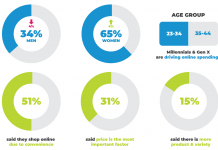According to the South African Council of Shopping Centres (SACSC), the secret of Blockchain is provenance: it shows, in a tamper-proof manner, exactly where the product or service originated and what processes it went through. One can almost call it a digital hallmark.
Like all the disruptive technologies that have upset the corporate applecart, Blockchain is deceptively simple. It is merely an app. But, also like all disruptive technologies, the ramifications of using it are massive, and the retail sector, particularly, can benefit hugely from adopting Blockchain as part of their supply chain management.
That might not sound all that impressive, but once the implications of provenance are unpacked, the possibilities are breathtaking. Blockchain can be used to identify fake goods, prevent fraud, facilitate billing, streamline payments, track stock, eliminate waste and comply with regulations. The Blockchain process starts with the person who downloads the app and assigns to their product or service a QR code.
The person who first downloads the app and gets their QR code, is now the first link in the chain. From now onwards, every step in the production chain is stored in a series of unbreakable links. Anyone, at any step of the process, can scan the QR code and the entire process is revealed, right back to the originator.
The first link in the chain can vary enormously. It can be: the farmer who grows the strawberries for the supermarket; the tanner who cures the hides for leather shoes; the textile company who sews the T-shirts; the diamond dealer who certifies the diamond; the photographer or the journalist who produces the photograph or the article. It can even extend to professional qualifications, making sure that an applicant for a job is able to prove their degree.
The person who starts the chain, therefore, is assured that their product is trackable, right up to consumption and beyond. The QR code is not the only part of Blockchain – but it is the visible manifestation for the consumer. Scanning the QR code will tell the consumer about the product itself. All the actors in the supply chain can use the app to track the goods across the entire supply spectrum, including sourcing, billing, payments, labelling, transport, packaging and marketing.
For retailers, the benefits are huge. Blockchain will tell the consumer where their tin of tuna comes from, where their coffee was grown and where their sneakers were manufactured. Shop owners, therefore, can claim Fair Trade practices or good governance and offer Blockchain as proof. Blockchain will add a layer of convenience to the stocktaking and stock tracking process. The product will arrive in the supply chain with a ready-made hallmark. Retailers simply take this over and feed it into their existing stock tracking system.
With ‘smart contracts’, the producer/retailer relationship is simplified. As soon as the item passes through the till, the producer is notified that their product has been sold and the payment process is activated. ‘Smart contracts’ are programmable according to each retailer’s mode of business and payment practice.
Although the actual provenance is set in stone, the functionality around the provenance is infinitely variable according to the requirements of the producer, the retailer and the customer. South African companies are lagging behind the rest of the world.
There are so many benefits to Blockchain. It can be applied to any product or process, and can, in fact, create an ecosystem of retailers. There is almost no limit to how it can benefit the retail industry, especially when it comes to customer relations and supply chain management. Shipping and transport becomes simplified, with a streamlined and paperless process. Only authorised parties can exchange data, obtain data, or access records, thereby enhancing security and regulatory compliance.
With import and export supply chains, paperwork can account for half of the cost of container transport. Products can be mislabelled or wrongly packed. But Blockchain networks create a shared IT infrastructure which streamlines the workflows for stakeholders. The transparency and traceability of blockchain provides accountability of goods and commodities from provenance to the point of purchase.
Blockchain provides transparency in the provenance of consumer goods from source to consumption. It assures accurate asset tracking and enhanced licencing of services, products and software. And recalls are easier and more cost-effective. The complex networks of supply chains would be streamlined with a Blockchain shared infrastructure. Added to this is the promise of Fair Trade practices or good governance that can be underwritten by the Blockchain infrastructure.
This article was sourced from www.sacsc.co.za










